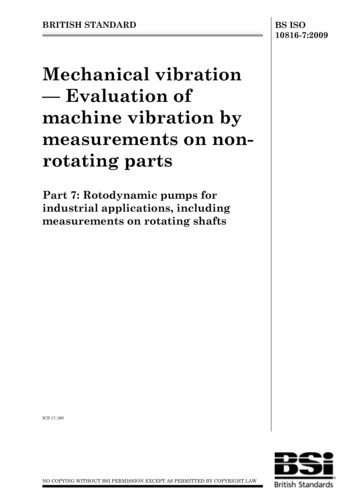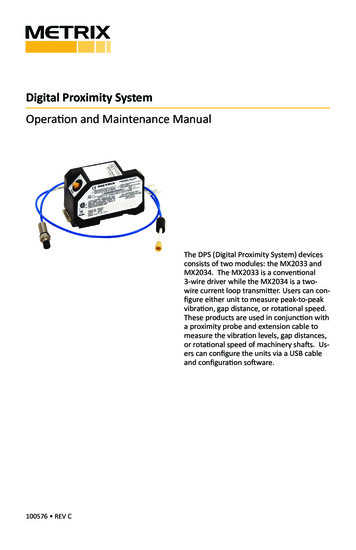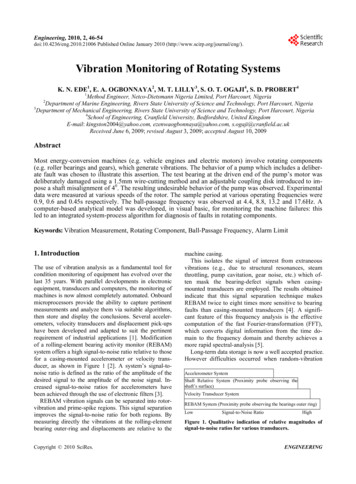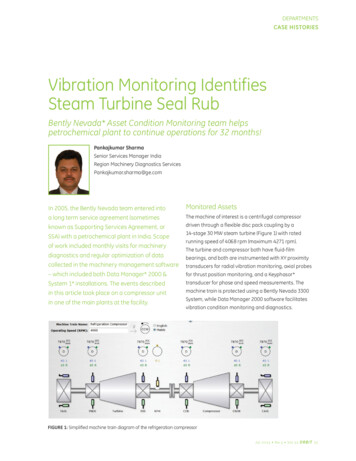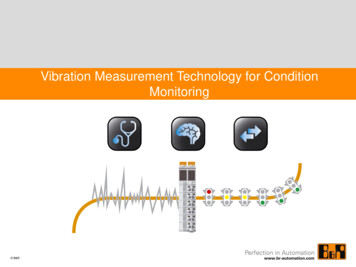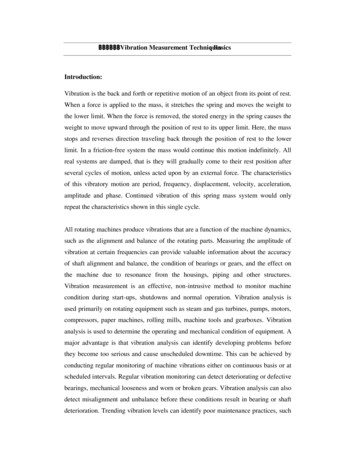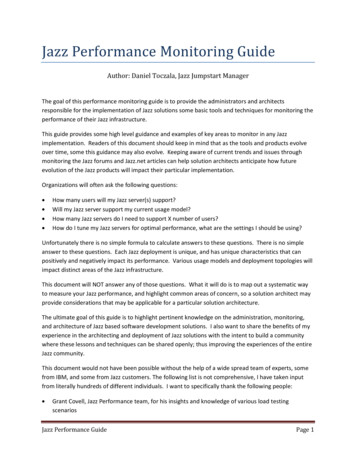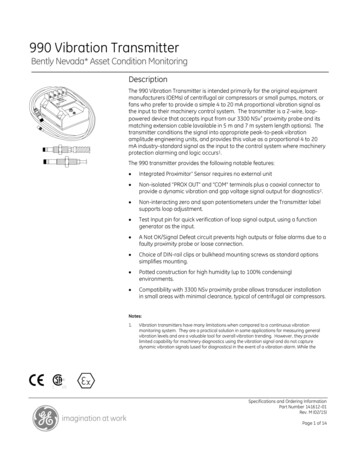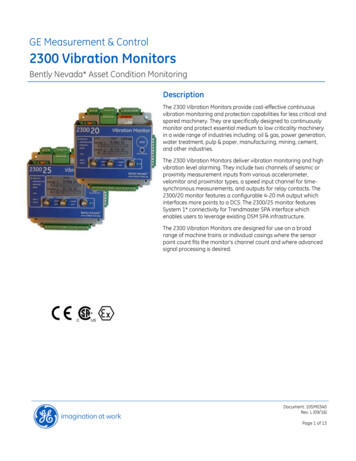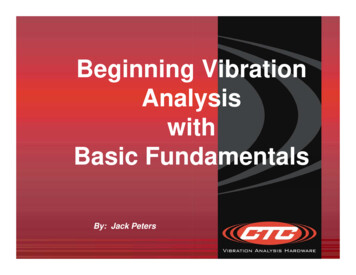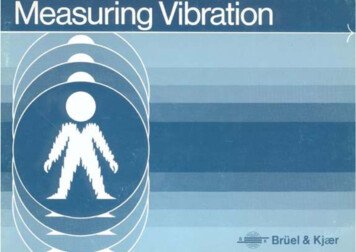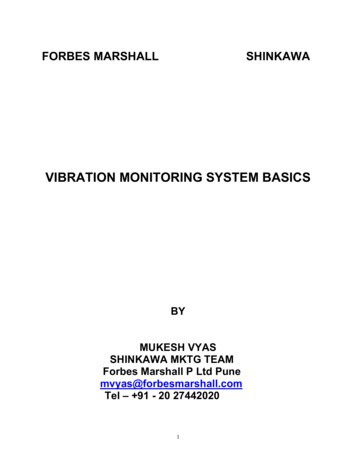
Transcription
FORBES MARSHALLSHINKAWAVIBRATION MONITORING SYSTEM BASICSBYMUKESH VYASSHINKAWA MKTG TEAMForbes Marshall P Ltd Punemvyas@forbesmarshall.comTel – 91 - 20 274420201
CONTENTS1. Basics of Vibration .2. Types of Vibration Monitoring Parameters.3. Vibration Monitoring Sensors & Selections.4. Vibration Monitoring Systems in Turbines.5. Vibration Monitoring System for Balance ofPlants.2
1. Basics of Vibration .3
1. FUNDAMENTALS OF VIBRATIONA. What is Machine Vibration?Most of us are familiar with vibration; a vibrating object moves to and fro, back and forth.A vibrating object oscillates.We experience many examples of vibration in our daily lives. A pendulum set in motionvibrates. A plucked guitar string vibrates. Vehicles driven on rough terrain vibrate, andgeological activity can cause massive vibrations in the form of earthquakes.There are various ways we can tell that something is vibrating. We can touch a vibratingobject and feel the vibration. We may also see the back-and-forth movement of avibrating object. Sometimes vibration creates sounds that we can hear or heat that wecan sense. To observe how vibration can create sound and heat, rub your feet back andforth on a carpet.In industrial plants there is the kind of vibration we are concerned about: machinevibration.What is machine vibration? Machine vibration is simply the back and forth movement ofmachines or machine components. Any component that moves back and forth oroscillates is vibrating.4
Machine vibration can take various forms. A machine component may vibrate over largeor small distances, quickly or slowly, and with or without perceptible sound or heat.Machine vibration can often be intentionally designed and so have a functional purpose.(Not all kinds of machine vibration are undesirable. For example, vibratory feeders,conveyors, hoppers, sieves, surface finishers and compactors are often used inindustry.)At other times machine vibration can be unintended and lead to machine damage. Mosttimes machine vibration is unintended and undesirable. This article is about themonitoring of undesirable machine vibration.Shown below are some examples of undesirable machine vibration.Perhaps the simplest illustration of a mechanical vibration is a vertical spring withweight, as shown in Figure 1. In this position, the deflection of the spring from its freestate is just sufficient to counterbalance the weight W. This deflection is called the staticdeflection of the spring. The position in which the spring is at rest is #1. The spring isthen slowly extended to position #2, and released. The subsequent motion of the weightas a function of time, when there is negligible resistance to the motion, is wavy andrepetitive as shown in the graph. It exhibits many of the basic characteristics ofmechanical vibrations.The maximum displacement from the rest or mean position is called the AMPLITUDE ofthe vibration. The vibratory motion repeats itself at regular intervals (A1, A2, A3). Theinterval of time within which the motion sequence repeats itself is called a CYCLE or5
PERIOD. The number of cycles executed in a unit time (for example, during one secondor during one minute), is known as the FREQUENCY. In a high-speed oscillation thefrequency is high and conversely. When, as in Figure 1, the spring-weight system is notdriven by an outside source, the vibration is a FREE VIBRATION and the frequency iscalled the NATURAL FREQUENCY of the system.In general, vibratory motion may or may not be repetitive and its shape as a function oftime may be simple or complex.Typical vibrations, which are repetitive and continuous, are those of the base or housingof an electric motor, household fans, vacuum cleaners and sewing machines, forexample.Vibrations of short duration and variable intensity are frequently Initiated by a suddenimpact or shock load; for example, rocket equipment upon takeoff, equipment subject toimpact and drop tests, a package falling from a height, or a lading in a freight car.In many machines, the vibration is not part of its regular or intended operation andfunction, but rather it cannot be avoided. The task of vibration isolation is to control thisunwanted vibration so that its adverse effects are kept within acceptable limits.B. What Causes Machine Vibration?6
Almost all machine vibration is due to one or more of these causes:(a) Repeating forces(b) Looseness(c) Resonance(a) Repeating ForcesImagine a boat anchored in a bay. Waves are slapping the sides of the boat, and aslong as the waves continue to act on the boat we would expect the boat to rock.The boat would be rocking because the waves would be exerting a repeating force onthe boat - a force of a pattern repeated over and over again.Most machine vibration is due to repeating forces similar to those causing the boat torock. Repeating forces such as these act on machine components and cause themachine to vibrate. Where do the repeating forces that cause machine vibration comefrom?Repeating forces in machines are mostly due to the rotation of imbalanced, misaligned,worn, or improperly driven machine components. Examples of these four types ofrepeating forces are shown below.7
8
(b) LoosenessLooseness of machine parts causes a machine to vibrate. If parts become loose,vibration that is normally of tolerable levels may become unrestrained and excessive.9
(c) ResonanceImagine a child swinging freely on a swing, that is, without the child propelling himself oranyone pushing him. If we observe the motion closely we will see the child swinging at aparticular rate. For example, we may see that it consistently takes him three seconds tocomplete one cycle of swinging.The rate of the child’s free-swinging is in fact a physical property of the child-swingsystem - much as the weight of the child is a physical property of the child. It is the rateat which the child will tend to swing while seated on that particular swing. It is the child’smost natural swinging rate on the swing, and the only way he can change it is tointerfere with the natural swinging by propelling himself with his feet, changing hisposture, rubbing his feet on the ground and so on.Machines also tend to vibrate at certain oscillation rates. The oscillation rate at which amachine tends to vibrate is called its natural oscillation rate. The natural oscillation rateof a machine is the vibration rate most natural to the machine, that is, the rate at whichthe machine 'prefers' to vibrate.A machine left to vibrate freely will tend to vibrate at its natural oscillation rate. Mostmachines have more than one natural oscillation rate. For example, a machinecomprising two substructures of different natural oscillation rates will exhibit at least twonatural oscillation rates. In general, the more complex the machine, the more naturaloscillation rates it has.Now consider again the child on the swing. If we aided the swinging motion byrepeatedly pushing the child, we would expect the child to swing higher and higher overtime.We would however only cause the child to swing higher and higher if we pushed withthe right rhythm. If our pushing rhythm is such that he is sometimes pushed down while10
he is ascending, we would not expect him to swing properly. To make him swing higherand higher, our pushing rhythm would in fact need to be in harmony with his naturaloscillation rate.For example, we could push him every time - or every alternate time - he reaches hishighest point. Only by pushing the child at a rate which is in harmony with his natural orpreferred oscillation rate can we cause him to quickly swing higher and higher.What happens if a machine is 'pushed' by a repeating force with a rhythm matching thenatural oscillation rate of the machine? A similar situation will arise – the machine willvibrate more and more strongly due to the repeating force encouraging the machine tovibrate at a rate it is most natural with. The machine will vibrate vigorously andexcessively, not only because it is doing so at a rate it 'prefers' but also because it isreceiving external aid to do so. A machine vibrating in such a manner is said to beexperiencing resonance.A repeating force causing resonance may be small and may originate from the motionof a good machine component. Such a mild repeating force would not be a problem untilit begins to cause resonance. Resonance, however, should always be avoided as itcauses rapid and severe damage. For example, whole bridges have collapsed due totheir natural oscillation rates being excited by the mere rhythm of soldiers marching inunison across the bridges.C. Why Monitor Machine Vibration?To do a good job of monitoring machine vibration and to fully reap the benefits, we mustunderstand the answers to the above question. Monitoring the vibration characteristicsof a machine gives us an understanding of the 'health' condition of the machine. We canuse this information to detect problems that might be developing.Why be concerned about the condition of a machine? Why not just continue to run themachine until it breaks down and then repair it? Operating a machine until it breaksdown might be acceptable if the machine were a 'disposable' one. Most machines,however, are not 'disposable' due to their cost.If we regularly monitor the conditions of machines we will find any problems that mightbe developing, therefore we can correct the problems even as they arise.In contrast, if we do not monitor machines to detect unwanted vibration the machinesare more likely to be operated until they break down.11
Because machine vibration monitoring finds potentially damaging vibration, we canprevent problems arising and this saves a lot of time, money, and frustration. How?Below we discuss some common problems that can be avoided by monitoring machinevibration. These problems are worth avoiding as the costs of dealing with them are largeand far exceed the cost of reasonably priced machine vibration monitoring programs.(a) Severe Machine DamageMachine vibration that is not detected early enough will often lead to severe machinedamage requiring costly repairs or even total machine replacement. However, if thecondition of a machine is monitored regularly, potential problems can be detected – andcorrected - at an early stage when the repair required is simpler, faster, and cheaper.This is similar to our own health. Regular visits to a doctor help us to detect problemsearly and so avoid the large costs of remedying severe health damage.(b) High Power ConsumptionA machine that is vibrating consumes more power. As well as the power required for themachine to perform its intended function, additional power is also required to sustain thevibration. We can minimize this problem by regularly monitoring and maintaining themachine.12
(c) Machine UnavailabilityBecause an unmonitored machine is more likely to break down, it is more often out ofaction. However, the cost of procuring and operating a machine is normally justified byits availability to process goods efficiently, or by its availability to convert raw materialinto cash. A machine should be consistently available to generate the money to justifyits investment. Regular monitoring helps ensure that a machine is always available togenerate money.(d) Delayed ShipmentsBecause an unmonitored machine is more likely to break down, it is also more likely tocause delays in the shipping of goods. Customers have to wait and their payment isdelayed. Customers could also cancel their order and stop doing business with us.(e) Accumulation of Unfinished GoodsBecause an unmonitored machine is prone to breaking down it is often unavailable.Goods still in the making tend to get stuck at the input point of the machine. This leadsto unnecessary wastage – the waiting goods run the risk of spoiling, occupy floor space,and tie up money.13
(f) Unnecessary MaintenanceTo constantly ensure proper machine condition, some companies stop runningmachines according to predetermined schedules to adjust and replace parts regardlessof whether or not the machines are malfunctioning. As a result, machines are oftenstopped unnecessarily to replace parts that are still good and to correct problems thatdo not exist. We can avoid such waste if the machines are regularly monitored andrepaired only when necessary.(g) Quality ProblemsSometimes a machine can be running into trouble even though it appears to befunctioning normally. This is a dangerous situation. If not caught early, the problemcould lead to poor quality products being made, large yield losses, rework costs, orworse still, warranty returns by irate customers. A machine that is regularly monitored isless likely to lead to such problems.14
(h) Bad Company ImageWe noted above that machines that are not regularly monitored can lead to shipmentdelays and produce goods of poor quality. Just one incident of shipment delinquency orproduct defect is often enough to seriously strain or even end relationships withcustomers. A bad company image associated with shipment delays and poor quality issomething to be avoided. For a relatively small cost, machine vibration monitoring canprotect customer relations and thus profitability.(i) Occupational HazardsDue to the noise and shaking they create, vibrating machines can cause occupationalhazards and human discomfort. Human discomfort results in a loss to the company asworkers who feel unwell will not be fully productive. Also, unexpected machinebreakdowns leave workers with no work, and production planners with frustration.15
2. Types of Vibration Monitoring Parameters.16
2.1. PRINCIPLEVibration amplitude may be measured as a displacement, a velocity, or acceleration.Vibration amplitude measurements may either be relative, or absolute.An absolute vibration measurement is one that is relative to free space. Absolutevibration measurements are made with seismic vibration transducers. Seismic vibrationtransducers include
7. Almost all machine vibration is due to one or more of these causes: (a) Repeating forces (b) Looseness (c) Resonance. (a) Repeating Forces Imagine a boat anchored in a bay. Waves are slapping the sides of the boat, and as long as the waves continue to act on the boat we would expect the boat to rock.
